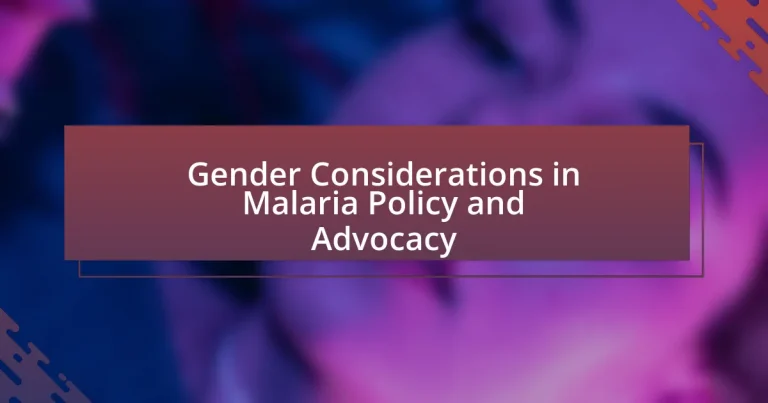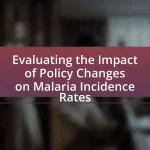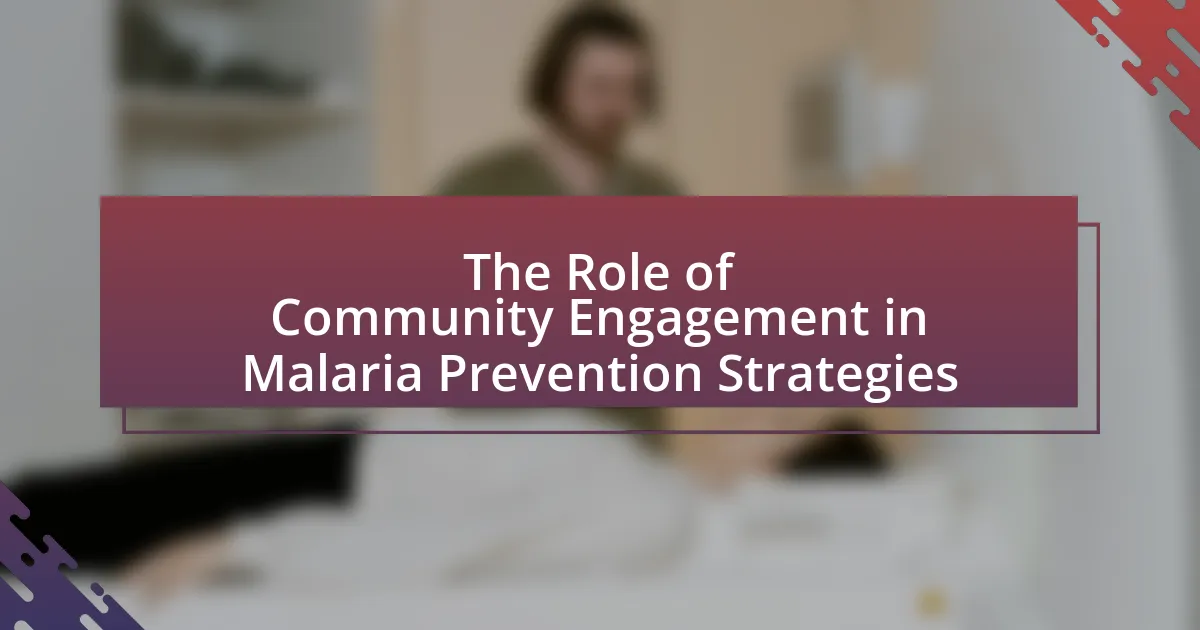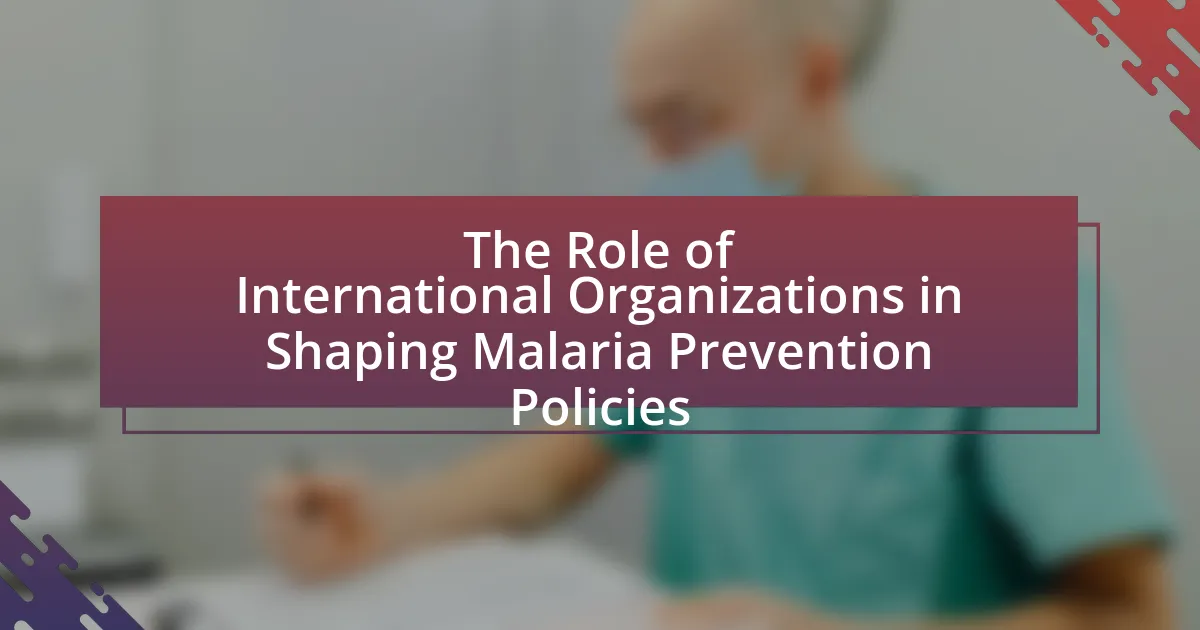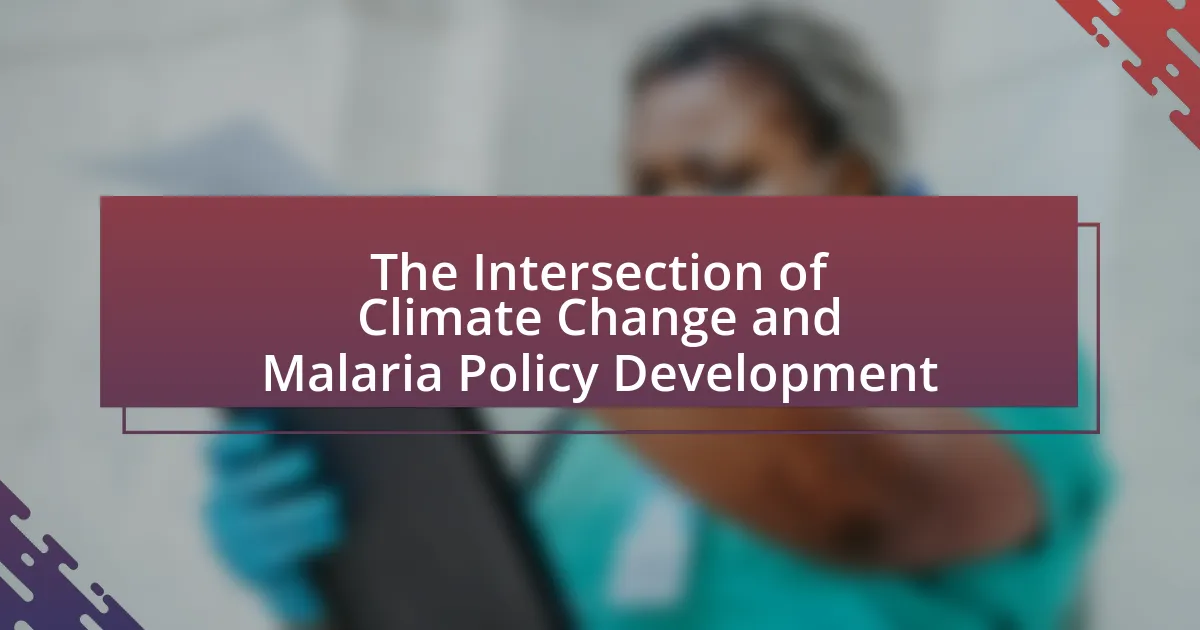The article focuses on gender considerations in malaria policy and advocacy, emphasizing the need to recognize and address the distinct impacts of malaria on different genders, particularly women and men. It highlights how gender roles influence access to healthcare, treatment outcomes, and the effectiveness of malaria interventions. The article discusses the implications of ignoring gender in malaria strategies, the specific challenges women face, and the importance of integrating gender-sensitive approaches into malaria programs. Additionally, it outlines frameworks for incorporating gender into malaria policies, best practices for implementation, and the role of data collection in informing gender-focused advocacy efforts.
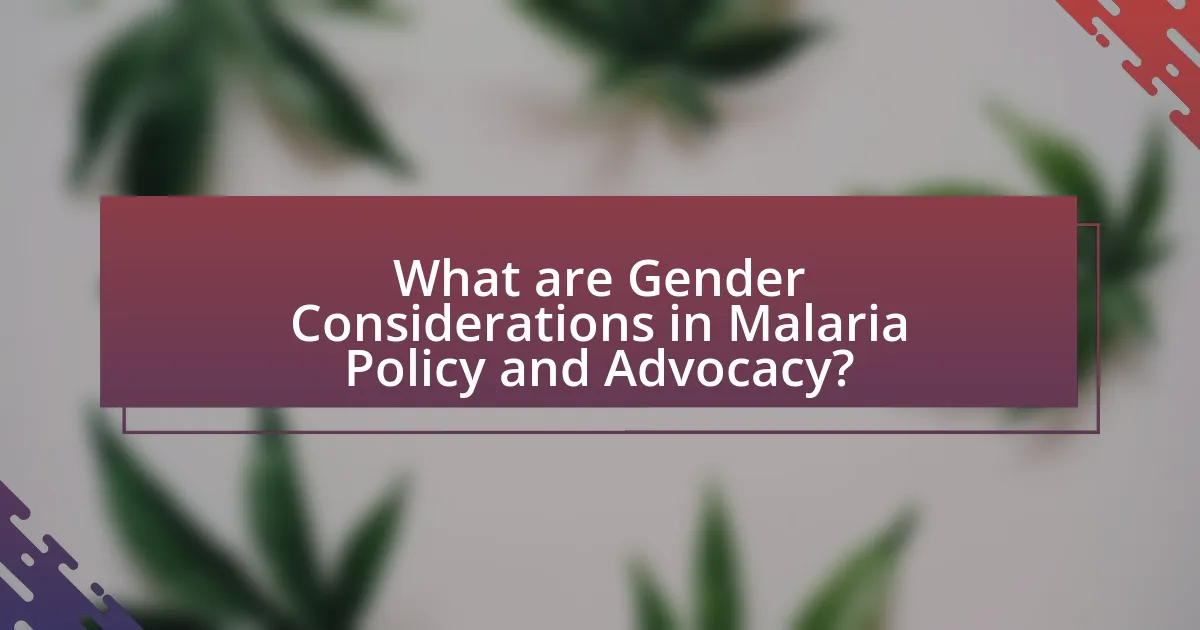
What are Gender Considerations in Malaria Policy and Advocacy?
Gender considerations in malaria policy and advocacy involve recognizing and addressing the different impacts of malaria on various genders, particularly women and men, to ensure equitable health outcomes. Women often bear a disproportionate burden of malaria due to their roles in caregiving and household responsibilities, which can affect their access to prevention and treatment services. Additionally, gender norms can influence the distribution of resources and decision-making in health care, impacting the effectiveness of malaria interventions. Research indicates that integrating gender analysis into malaria programs can enhance their effectiveness; for instance, the World Health Organization emphasizes that gender-sensitive approaches can improve health outcomes and increase community engagement in malaria control efforts.
Why is gender a critical factor in malaria policy and advocacy?
Gender is a critical factor in malaria policy and advocacy because it influences vulnerability, access to healthcare, and the effectiveness of interventions. Women and men experience malaria differently due to biological, social, and economic factors; for instance, women often bear the burden of caregiving and may have less access to health resources, which can affect treatment outcomes. Research indicates that gender-sensitive approaches can improve malaria control efforts; for example, a study published in the Lancet Global Health found that integrating gender considerations into malaria programs led to increased utilization of preventive measures among women. Therefore, addressing gender disparities is essential for effective malaria policy and advocacy.
How do gender roles influence malaria transmission and treatment?
Gender roles significantly influence malaria transmission and treatment by affecting access to healthcare, responsibilities in household management, and decision-making power. In many regions, women are primarily responsible for childcare and household duties, which can limit their ability to seek treatment or preventive measures for malaria. For instance, studies show that women often prioritize family health over their own, leading to delays in seeking care for malaria symptoms. Additionally, gender norms can restrict women’s mobility, making it difficult for them to access health facilities or participate in malaria prevention programs. Furthermore, men may have more authority in health-related decisions, which can impact the uptake of malaria interventions within families. Evidence from the World Health Organization indicates that addressing these gender disparities can improve malaria control efforts, as inclusive strategies that consider gender dynamics lead to better health outcomes.
What are the implications of ignoring gender in malaria strategies?
Ignoring gender in malaria strategies leads to ineffective interventions and exacerbates health disparities. Research indicates that women and men experience malaria differently due to biological, social, and economic factors, which influence susceptibility and access to treatment. For instance, women often bear the burden of caregiving, impacting their ability to seek timely medical care, while men may have higher exposure due to occupational risks. A study published in the Malaria Journal highlights that gender-sensitive approaches can improve treatment adherence and health outcomes, demonstrating that tailored strategies are essential for effective malaria control. Thus, neglecting gender considerations not only undermines the efficacy of malaria programs but also perpetuates inequalities in health access and outcomes.
How do gender disparities affect malaria outcomes?
Gender disparities significantly affect malaria outcomes by influencing access to prevention, treatment, and healthcare resources. Women often face barriers such as limited mobility, cultural restrictions, and economic dependence, which can hinder their ability to seek timely medical care. For instance, studies have shown that women in malaria-endemic regions are less likely to receive prompt treatment compared to men, leading to higher morbidity and mortality rates among women. Additionally, gender roles can affect the distribution of resources, with women frequently being responsible for household health but lacking decision-making power regarding health interventions. This disparity contributes to unequal health outcomes, as evidenced by research indicating that women and children are disproportionately affected by malaria, accounting for a significant percentage of malaria-related deaths.
What specific challenges do women face in malaria prevention and treatment?
Women face specific challenges in malaria prevention and treatment, including limited access to healthcare services, socio-economic barriers, and cultural norms that restrict their autonomy. Limited access to healthcare services often results from inadequate health infrastructure and a lack of female healthcare providers, which can deter women from seeking treatment. Socio-economic barriers, such as poverty and lack of education, further hinder women’s ability to access preventive measures like insecticide-treated bed nets and antimalarial medications. Cultural norms may impose restrictions on women’s mobility and decision-making power, affecting their ability to seek care or participate in malaria prevention programs. These challenges are supported by data indicating that women in malaria-endemic regions often experience higher morbidity and mortality rates due to these systemic inequalities.
How do men and women differ in their access to malaria resources?
Men and women differ significantly in their access to malaria resources, primarily due to socio-cultural factors and economic disparities. Women often have less access to information, healthcare services, and financial resources necessary for malaria prevention and treatment. For instance, studies show that women in many regions are less likely to own insecticide-treated nets compared to men, which directly impacts their ability to protect themselves and their families from malaria. Additionally, women’s roles in caregiving often limit their mobility and access to health facilities, further exacerbating their vulnerability to malaria. This gender disparity in access to malaria resources highlights the need for targeted interventions that consider these differences to improve health outcomes for both men and women.
What frameworks exist for integrating gender into malaria policies?
Several frameworks exist for integrating gender into malaria policies, including the Gender Responsive Health Systems Framework, the Gender and Health Policy Framework, and the WHO Gender and Health Strategy. The Gender Responsive Health Systems Framework emphasizes the need for health systems to address gender inequalities and ensure equitable access to malaria prevention and treatment. The Gender and Health Policy Framework provides guidelines for incorporating gender considerations into health policies, including malaria. The WHO Gender and Health Strategy outlines actions to promote gender equality in health, specifically targeting diseases like malaria. These frameworks are supported by evidence indicating that gender disparities significantly impact malaria outcomes, highlighting the necessity for gender-sensitive approaches in policy formulation.
What are the key components of gender-sensitive malaria policies?
Key components of gender-sensitive malaria policies include the integration of gender analysis in malaria research, the consideration of gender-specific vulnerabilities and access to healthcare, and the involvement of women in decision-making processes. Gender analysis helps identify how malaria affects different genders differently, ensuring that interventions are tailored to meet the specific needs of both men and women. Recognizing gender-specific vulnerabilities, such as women’s roles in caregiving and their access to health services, allows for more effective prevention and treatment strategies. Additionally, involving women in policy-making ensures that their perspectives and experiences shape malaria interventions, leading to more equitable health outcomes.
How can stakeholders implement gender considerations effectively?
Stakeholders can implement gender considerations effectively by integrating gender analysis into malaria policy and advocacy frameworks. This involves assessing how malaria affects different genders differently, ensuring that both men and women have equal access to prevention and treatment services. For instance, research shows that women often face barriers to accessing healthcare due to socio-cultural factors, which can lead to higher morbidity rates. By collecting gender-disaggregated data, stakeholders can identify specific needs and tailor interventions accordingly, such as providing targeted education and resources for women. Additionally, involving women in decision-making processes related to malaria programs enhances the relevance and effectiveness of these initiatives, as evidenced by successful case studies in various countries where women’s participation led to improved health outcomes.

How can gender considerations enhance malaria advocacy efforts?
Gender considerations can enhance malaria advocacy efforts by ensuring that interventions are tailored to the specific needs and roles of different genders in affected communities. For instance, women often bear the brunt of malaria’s health impacts due to their roles as caregivers and primary health decision-makers in households. Research indicates that women are more likely to seek healthcare for children, which can lead to increased treatment rates and better health outcomes when they are engaged in advocacy efforts. Furthermore, incorporating gender perspectives can improve the effectiveness of communication strategies, as messages that resonate with both men and women can lead to higher community engagement and support for malaria prevention initiatives. Studies have shown that gender-sensitive approaches can increase the uptake of preventive measures, such as insecticide-treated nets, by addressing barriers specific to each gender, thus ultimately reducing malaria transmission rates.
What strategies can be employed to promote gender equity in malaria advocacy?
To promote gender equity in malaria advocacy, strategies must include integrating gender analysis into malaria programs, ensuring women’s representation in decision-making processes, and addressing gender-specific barriers to accessing malaria prevention and treatment. Integrating gender analysis allows for the identification of how malaria affects different genders uniquely, which can inform targeted interventions. Ensuring women’s representation in decision-making processes is crucial, as studies show that diverse leadership leads to more comprehensive health policies. Addressing gender-specific barriers, such as economic constraints and cultural norms, is essential for improving access to malaria services for women, who often bear the brunt of the disease’s impact.
How can community engagement address gender issues in malaria?
Community engagement can address gender issues in malaria by fostering inclusive participation and empowering women in decision-making processes related to malaria prevention and treatment. Engaging communities allows for the identification of specific gender-related barriers, such as unequal access to healthcare and cultural norms that may hinder women’s health-seeking behaviors. For instance, studies have shown that when women are involved in community health initiatives, there is a significant increase in the uptake of malaria prevention measures, such as the use of insecticide-treated nets. This empowerment not only improves health outcomes but also enhances women’s roles as health advocates within their communities, leading to more effective malaria control strategies.
What role do partnerships play in advancing gender-focused malaria advocacy?
Partnerships play a crucial role in advancing gender-focused malaria advocacy by facilitating collaboration among diverse stakeholders, including governments, NGOs, and community organizations. These partnerships enhance resource mobilization, knowledge sharing, and the implementation of gender-sensitive strategies that address the unique vulnerabilities of women and girls to malaria. For instance, the Global Fund to Fight AIDS, Tuberculosis and Malaria emphasizes the importance of gender equality in its funding criteria, which encourages partnerships that prioritize women’s health and empowerment in malaria interventions. This collaborative approach leads to more effective advocacy efforts, ensuring that gender considerations are integrated into malaria policies and programs, ultimately improving health outcomes for affected populations.
How can data collection improve gender considerations in malaria advocacy?
Data collection can improve gender considerations in malaria advocacy by providing evidence on how malaria affects different genders differently, thus informing targeted interventions. For instance, research indicates that women often bear a disproportionate burden of malaria due to their roles in caregiving and agricultural work, which can lead to increased exposure to malaria vectors. By systematically collecting gender-disaggregated data, stakeholders can identify specific vulnerabilities and tailor advocacy efforts to address the unique needs of men and women. This approach has been supported by studies such as the World Health Organization’s report on gender and malaria, which highlights the importance of understanding gender dynamics in health outcomes to enhance the effectiveness of malaria control strategies.
What types of data are essential for understanding gender dynamics in malaria?
Essential data for understanding gender dynamics in malaria includes epidemiological data disaggregated by gender, socioeconomic status, access to healthcare, and cultural practices. Epidemiological data reveals differences in malaria prevalence and outcomes between genders, highlighting how biological and social factors influence susceptibility and treatment. Socioeconomic data provides insights into how economic status affects access to prevention and treatment resources, while healthcare access data illustrates disparities in service utilization between men and women. Cultural practices data helps to understand gender roles and responsibilities that may impact exposure to malaria and health-seeking behavior. Collectively, these data types enable a comprehensive analysis of how gender influences malaria dynamics, informing targeted interventions and policies.
How can data inform policy changes regarding gender and malaria?
Data can inform policy changes regarding gender and malaria by highlighting disparities in malaria incidence and treatment access between genders. For instance, research indicates that women and children are disproportionately affected by malaria, with women often facing barriers to accessing healthcare due to socio-economic factors. Data collection on malaria prevalence, treatment outcomes, and gender-specific barriers can guide policymakers in developing targeted interventions. For example, the World Health Organization’s Global Malaria Programme emphasizes the need for gender-sensitive approaches in malaria control, which are informed by data showing that women’s roles in household health decisions significantly impact malaria prevention and treatment. This evidence-based approach ensures that policies are tailored to address the unique challenges faced by different genders, ultimately improving malaria outcomes.
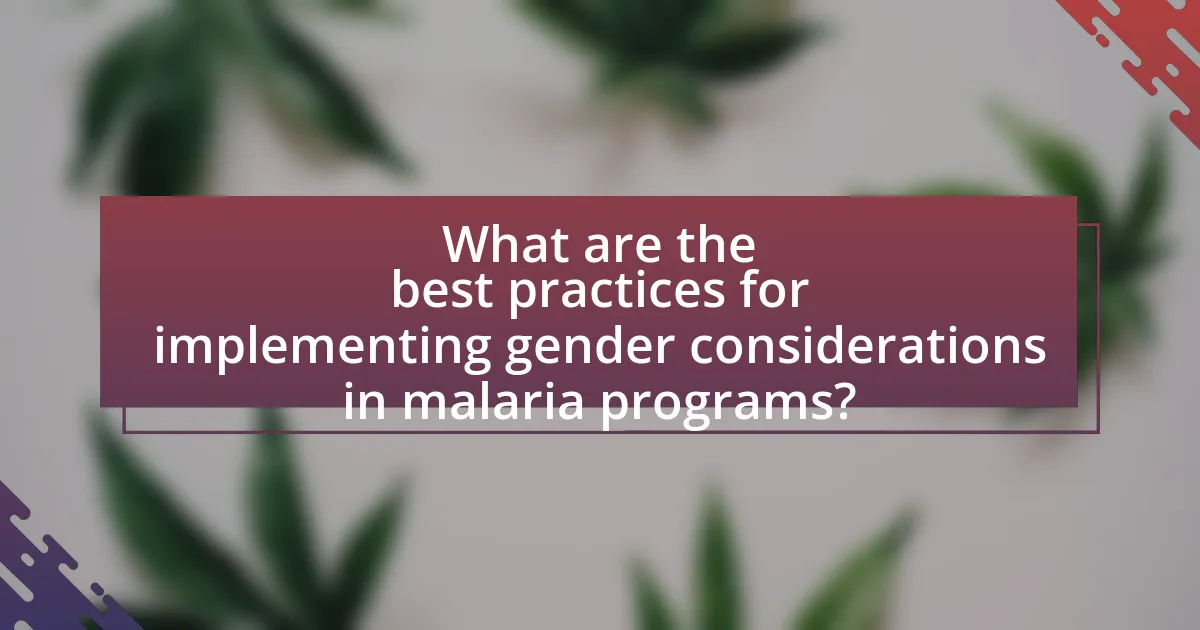
What are the best practices for implementing gender considerations in malaria programs?
The best practices for implementing gender considerations in malaria programs include conducting gender-sensitive assessments, ensuring equitable access to prevention and treatment, and involving both men and women in program design and implementation. Gender-sensitive assessments help identify specific vulnerabilities and barriers faced by different genders, which can inform targeted interventions. Ensuring equitable access involves addressing socio-economic factors that may hinder access to malaria services for women, who often bear the brunt of caregiving responsibilities. Involving both genders in program design fosters community ownership and enhances the effectiveness of interventions, as evidenced by studies showing that inclusive approaches lead to better health outcomes.
What lessons can be learned from successful gender-sensitive malaria initiatives?
Successful gender-sensitive malaria initiatives demonstrate the importance of tailoring interventions to address the specific needs and roles of different genders. These initiatives reveal that engaging women in decision-making processes significantly enhances community acceptance and participation in malaria prevention efforts. For instance, programs that incorporate women’s perspectives have shown improved health outcomes, as women often serve as primary caregivers and play a crucial role in household health decisions. Evidence from the World Health Organization indicates that gender-sensitive approaches can lead to a 30% increase in the use of preventive measures, such as insecticide-treated nets, when women are actively involved in the planning and implementation phases. Additionally, these initiatives highlight the necessity of addressing socio-economic barriers that disproportionately affect women, such as access to healthcare and education, which can further improve malaria control efforts.
How can training and capacity building support gender integration in malaria programs?
Training and capacity building can significantly support gender integration in malaria programs by equipping stakeholders with the necessary skills and knowledge to address gender-specific barriers in malaria prevention and treatment. For instance, targeted training can enhance the understanding of how gender roles influence access to healthcare services, thereby enabling program implementers to design interventions that are more inclusive. Evidence from the World Health Organization indicates that gender-sensitive approaches in health programs lead to improved health outcomes, as they address the unique needs of different genders. By fostering an environment where both men and women can participate equally in malaria programs, training and capacity building ultimately contribute to more effective and equitable health interventions.
What monitoring and evaluation methods are effective for gender-focused malaria interventions?
Effective monitoring and evaluation methods for gender-focused malaria interventions include gender-disaggregated data collection, participatory approaches, and gender-sensitive indicators. Gender-disaggregated data collection allows for the analysis of malaria’s impact on different genders, revealing disparities in infection rates and access to treatment. Participatory approaches engage both men and women in the evaluation process, ensuring that their perspectives and experiences inform the intervention’s effectiveness. Gender-sensitive indicators, such as the proportion of women receiving preventive measures or treatment, provide measurable outcomes that reflect the intervention’s impact on gender equity. These methods have been validated by studies demonstrating that gender-focused evaluations lead to more effective malaria control strategies, as they address the unique needs and barriers faced by different genders in accessing malaria prevention and treatment services.
What practical steps can organizations take to incorporate gender considerations in malaria policy?
Organizations can incorporate gender considerations in malaria policy by conducting gender-sensitive assessments to identify specific vulnerabilities and needs of different genders in malaria prevention and treatment. These assessments should analyze data on malaria incidence and treatment access, disaggregated by gender, to inform targeted interventions. Additionally, organizations should engage women and men in the policy-making process to ensure diverse perspectives are represented, thereby enhancing the relevance and effectiveness of malaria strategies. Training healthcare providers on gender-sensitive approaches can further improve service delivery, ensuring that both men and women receive equitable care. Evidence from the World Health Organization indicates that integrating gender into health policies leads to improved health outcomes and more effective disease control measures.
How can organizations assess their current gender integration efforts?
Organizations can assess their current gender integration efforts by conducting comprehensive gender audits that evaluate policies, practices, and outcomes related to gender equity. These audits involve collecting and analyzing data on gender representation, participation rates, and the impact of gender-focused initiatives within the organization. For instance, the World Health Organization emphasizes the importance of gender-responsive approaches in health policies, highlighting that organizations should track gender-disaggregated data to identify gaps and measure progress. By utilizing tools such as surveys, focus groups, and performance metrics, organizations can gain insights into the effectiveness of their gender integration strategies and make informed adjustments to enhance gender equity in their operations.
What resources are available for organizations seeking to enhance gender considerations in malaria advocacy?
Organizations seeking to enhance gender considerations in malaria advocacy can access various resources, including guidelines, toolkits, and research publications. The World Health Organization (WHO) provides a Gender and Health Toolkit that offers strategies for integrating gender into health programs, including malaria. Additionally, the Roll Back Malaria Partnership has developed resources that focus on gender-responsive malaria programming, emphasizing the importance of addressing gender disparities in malaria prevention and treatment. Research studies, such as those published in the Malaria Journal, provide empirical evidence on the impact of gender on malaria outcomes, helping organizations tailor their advocacy efforts effectively. These resources collectively support organizations in implementing gender-sensitive approaches in malaria advocacy.
